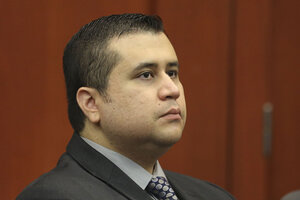Zimmerman trial: Did wall-to-wall media coverage inform, or entertain?
While some say the extensive media coverage of the George Zimmerman trial provided a civics lesson to the US public, others saw a play for ratings that did little to address key issues in the case.

George Zimmerman sits in Seminole circuit court during his trial in Sanford, Fla. Wednesday, July 10, 2013. Zimmerman has been charged with second-degree murder for the 2012 shooting death of Trayvon Martin.
Gary W. Green, Orlando Sentinel/AP
Los Angeles
As the trial of George Zimmerman, charged with second-degree murder for the shooting death of Trayvon Martin, nears its end, the swirl of media that has followed every sound clip, scrap of evidence, and testimony in the proceedings has once again put media on the hot seat for the way they handle high-profile legal cases.
Because the reporting has often elbowed key international stories out of the way, such as the ongoing Egyptian political crisis, there is much hand-wringing – also in the media – about tabloid-style overkill.
Arianna Huffington, founder of the Huffington Post, tweeted “Wall-to-wall Zimmerman trial coverage doesn't seem like the best way to honor Trayvon's memory.” Mark Knoller, White House correspondent for CBS, also tweeted, “Zimmerman Trial is a legitimate news story, but national wall-to-wall coverage seems excessive.”
On the flip side are those who suggest that such widespread exposure of the criminal justice system is a good thing, providing a real-time civics lesson for the American public.
Many people are unaware of how the legal system works and what really happens at a trial, says Larry Burriss, journalism professor at Middle Tennessee State University in Murfreesboro. “Thus the coverage, and commentary, have provided what I think is an important educational function,” he adds via e-mail.
“The media has many roles in educating the public,” agrees Georgia attorney Lance LoRusso, author of “When Cops Kill.” “They can also entertain and inflame the public,” he says, “but in general people are very interested in the law, especially when it comes to the use of deadly force.”
Indeed, he says the legal system itself encourages a high level of attention in cases that result in death. “When a person is killed at the end of a confrontation, he not only loses his life but his civil liberties under our system of justice,” he notes. “So there is a great deal of scrutiny of anyone who takes a life.”
The obsession with blow-by-blow analysis sidesteps any meaningful discussion of race relations in America, says Julian Chambliss, associate history professor at Rollins College in Winter Park, Fla.
“Media pundits are quick to point to hints of success and or failure, but these positions are doing little to address the fundamental tensions around racial assumptions that play in the background of the trial,” he adds.
Instead of tackling the deeper themes, the trial coverage predictably focuses on the tabloid-esque elements that will drive ratings for commercial media, says Maurice Hall, communications professor at Villanova University in Philadelphia.
“The initial storyline that captured our attention about an innocent 17-year-old victim and a hard-charging community vigilante has morphed into a more nuanced narrative about two troubled young men whom fate brought together for a tragic meeting,” he says via e-mail. The events from that night have the element of mystery and uncertainty, he says, that are so familiar to regular viewers of media staples such as “CSI.”
“It is unclear who attacked whom first, and it is unclear whether the fatal shot marked a moment of self-defense or murder,” he says. “The parade of witnesses, as diverse as they are compelling, add to the sense that we are watching an unfolding mystery narrative.”
At minimum, this courtroom trial has something for everyone, even if their minds are already made up, says Richard Goedkoop, retired communication professor at La Salle University in Philadelphia.
The implications of issues of race, crime, and violence have made the trial a simmering topic on the television and cable news agenda, he says. This continuous reporting allows viewers to look at elements of each day's coverage to confirm those views, he says. “Others who may be unsure," he continues, "can place themselves in the minds of the jurors weighing each piece of evidence and determining the credibility of each side's witnesses as they contradict each other,” he says via e-mail, adding that it is predictable summer programming.
“Fewer people are watching their sets,” he says, “and with the dearth of soap operas on the small screen, here is a tragic substitute.”

